![]()
![]()
![]()
Use LEFT and RIGHT arrow keys to navigate between flashcards;
Use UP and DOWN arrow keys to flip the card;
H to show hint;
A reads text to speech;
97 Cards in this Set
- Front
- Back
|
preterm, term, etc. |
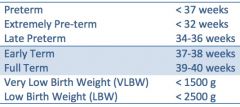
**bigger is better; delay deliveries until 39 weeks |
|
|
corrected age |
**actual -- weeks of premature correct for 2 years; most meaningful in first year of life |
|
|
catch up |
head circumference-- • early catch up in first few months post term unless ELBW
weight and length-- • catch up by 1st year if > 30 weeks • catch up by 2nd year if < 30 weeks |
|
|
contributing factors of prematurity |
• advanced maternal age • HTN; vasoconstriction >> placental insufficiency • IUGR • gestational DO • chronic health DO • assisted reproductive technologies • multiple births • c-sections |
|
|
4 Us of late preterm & early term infants |
1/ unrecognized as premature • may not be transferred to NICU
2/ underestimated for morbidity & mortality • 3x higher than term infants • 19% risk of NICU admission
3/ unpredictable • hypothermia • hypoglycemia; short liver, (-) glycogen stores • respiratory support
4/ understudied
|
|
|
Why do premies experience respiratory distress? |
Surfactant is not produced until week 34 |
|
|
What labs are needed for premies from the nursery? |
• blood type • glucose screening • bilirubin • CBC • coombs test • rapid plasma reagin (RPR) |
|
|
When should premies have their first well visit? |
**within 48 hours of discharge sooner if closer monitoring or further screening needed |
|
|
first visit |
• adaptation to home environment • parental adjustment / bond • reassurance • review thorough history, i.e. NICU summary • discuss plans of health care maintenance, immunizations, & referrals • get to know infant |
|
|
T/F. Mothers of premies have higher rates of maternal depression. |
True; depressed moms are more likely to have an infant w/ poor growth & development >> perform edinburg postpartum depression scale |
|
|
premie hospital readmissions |
• 25-58% • dehydration, respiratory, & feeding issues • can continue to have higher rates during 2nd year of life |
|
|
premie PE |
throat-- • suck-swallow • tongue trust • oral aversion • uvula movement • gag reflex
respiratory-- • RR, retractions, stridor • RSV patients wheeze
neck & shoulder-- • poor head control • tight scarf sign • difficulty bringing hands midline
trunk-- • arching • (-) ROM • hypotonia >> neuro f/u
extremities-- • hypo/hyper tone • hyperreflexia • clonus • babinski |
|
|
postural reflexes |
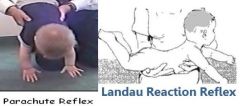
landau-- • present by 5-6 mos • lift & extend neck & trunk
parachute • present by 6-8 mos • look for symmetric response
propping reflex-- • anterior propping when sitting • lateral propping to maintain balance |
|
|
immunizations |
**AAP recommends immunizations based on chronological age
• hep B after 2 kg • palivizumab |
|
|
palivizumab |
**antibodies for preterm or at-risk infants for RSV
• 15 mg/kg monthly nov-april; 5 dose max • continue during 2nd year of life IF on O2 • stop if breakthrough RSV occurs w/ hospitalization |
|
|
premie weight gain |
15-20 g daily |
|
|
premie length |
**1.1 cm per week until term >> 0.75 cm for 3 mos >> 0.5 cm during 3-6 mos |
|
|
premie head circumference |
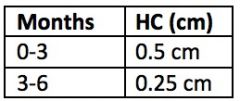
**hydrocephaly if 1.25+ cm per week |
|
|
nutritional needs |

**137-165 cal/kg/day chronic lung disease require higher calorie intake
premies have higher requirements due to-- • IUGR • gut immaturity • (+) BSA |
|
|
growth in VLBW infants |

**take longer to catch up; most catch up by 2-3 years |
|
|
feeding problems |
**parental support & education; teach how to pace child >> refer to specialist
• tonic bite reflex • tongue thrust • hyperactive gag reflex • oral hypersensitivity from NGT/OGT • microaspiration >> swallow study |
|
|
How long does it take for a full term infant to transition to extrauterine life? |
6-12 hours |
|
|
full VS |

|
|
|
heat loss |
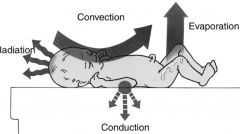
|
|
|
brown fat metabolism |
**newborns generate heat by lipoysis of brown fat brown fat storage begins @ 26-30 weeks
locations-- • scapula • kidneys • axilla • neck |
|
|
How do newborns respond to hyperthermia? |
• (+) CO • insensible water loss |
|
|
consequences of heat loss |
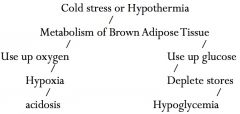
• hypoxia, apnea • pulmonary HTN • hypoglycemia • metabolic acidosis • (-) growth
>> can lead to death |
|
|
cold stress |
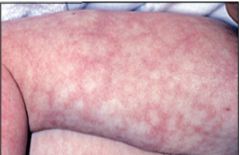
**rectal temp < 36.5 °C = 97.6 °F
s&S-- • cool to touch • central cyanosis • poor feeding • bradycardia • apnea • lethargy • mottling |
|
|
T/F. Newborns cannot sweat/shiver in the first year of life. |
True; tell parents to dress infant in one extra layer than what they would dress themselves |
|
|
umbilical cord care |
• dry it out >> falls within 7-10 days • observe moisture & odor for infection; if streaking present >> intervene |
|
|
penile care |
**discuss risk & benefits of circumcision
circumcision care-- • petroleum jelly
uncircumcised penis-- • retract foreskin >> visualize meatus >> clean |
|
|
sleeping pattern & positioning |
• back to sleep; no side or stomach • remove soft bedding, pillows, quilt, or stuffed animals >> suffocation |
|
|
elimination patterns |
**8-10 wet diapers **soft, yellow stool
• meconium should be passed within first 24 hours • breast milk babies have looser stool • formula fed babies have darker and better-formed stool • acholic stool- white, clay-like >> biliary issue >> GI consult |
|
|
T/F. A pacifier may be used within the first few hours of life. |
False; may start if established adequate breast feeding |
|
|
T/F. Smoking is associated w/ SIDS. |
True; assess infant's environment |
|
|
T/F. A child's carseat should be switched to rear facing at 1 year or 20 pounds. |
False; "1 and 20" are minimum requirements--not at time to switch **carseat should be rear facing until 2 yrs |
|
|
newborn screening |
hearing-- • mandatory for all newborns before d/c • if fail >> repeat • if fail 2x >> refer
metabolic screening-- • heel stick evaluated for 30+ conditions • guthrie spot must dry flat • parents may refuse for religious beliefs; state dependent |
|
|
metabolic screening timing |
**PNP need to be able to educate, draw specimen @ correct times, & f/u appropriately
• risk of false (-) or false (+) hypothyroidism if < 12 hours >> screen before d/c @ 48-96 hours • screen prior to transfusion • sick or preterm infants should be screened @ birth, 48-72 hours, 28 days or d/c |
|
|
cystic fibrosis (CF) |
• meconium ileus • intestinal obstruction |
|
|
congenital hypothyroidism |
• umbilical hernia • jaundice • enlarged fontanelle • macroglossia |
|
|
congenital heart defect screening |

@ 24 hours of life; compare pulse ox of R hand & foot b/c unable to see cyanosis at 80-95% |
|
|
criteria for discharge |
• gestation > 35 weeks • VS stable • cleared for d/c by HCP; provide name of new provider • no abnormal cardiorespiratory findings • no jaundice • hearing, metabolic, & CHD screens • cord clean & drying • circumcision not bleeding • suck/swallow coordination >> 2 successful feeds • voided/stooled spontaneously once • eye and vitamin K prophylaxis |
|
|
attachment red flags |
• no comfort seeking form caregiver • no checking back w/ caregiver hen exploring • no reaching out s/p brief separation |
|
|
What should be done if hyperbilirubinemia is suspected? |
1/ serum bilirubin 2/ transcutaneous bilirubin level if infant has no history & not severely jaundice |
|
|
causes of hyperbilirubinemia |
**based on mechanism of accumulation • bilirubin overproduction • (-) bilirubin conjugation, e.g. (-) albumin • impaired bilirubin excretion |
|
|
hyperbilirubinemia |
**serum bilirubin > 5 mg/dL • rate of rise is the most important thing • 13+ mg/dL can result in minor neurological finding • cephalocaudal progression; yellow sclera is late sign |
|
|
pathologic jaundice |
• within first 24 hours of life • rises > 5 mg/dL/day • > 17 mg/dL • s&s of serious illness |
|
|
estimated bilirubin levels |

|
|
|
jaundice risk factors |
hematological risk factors-- • ABO; mom is O, dad is A or B • G6PD; enzyme deficiency in african, asian, & middle eastern
maternal risk factors-- • breastfeeding • drugs, e.g. sulfa & strep • gestational DM; (+) erythropoietin >> polycythemia
neonatal risk factors-- • birth trauma, e.g. cephalohematoma • preterm & LBW infants • TORCH, i.e. CMV, herpes, toxoplasmosis • delayed passage of meconium >> unable to pass bilirubin • polycythemia
other factors-- • males > females • asians & american indians • high altitudes, e.g. greece |
|
|
physiologic jaundice |
• 3-5 days of life >> declines over first week • peaks @ 5-6 mg/dL; higher in asians @ 10 mg/dL |
|
|
jaundice treatment |
• no absolute level • bhatani nomogram- based on hours & risk factors • phototherapy- light changes structure in molecule >> cannot pass BBB • exchange transfusion |
|
|
Infants who present w/ severe jaundice that continues the past 1-2 weeks... |
think-- • galactosemia • congenital hypothyroidism • results of newborn metabolic screen |
|
|
jaundice PE |
• hepatosplenomegaly • petechiae • microcephaly a/w hemolytic anemia, sepsis, congenital infection |
|
|
jaundice differential diagnoses |
• biliary atresia • galactosemia • breast milk jaundice • hemolytic disease • cholestasis • hep B • CMV • hypothyroidism • duodenal atresia • dubin-johnson syndrome |
|
|
Which infants need further evaluation? |
• anemic @ birth • ill appearing • significant jaundice beyond first 2 weeks • family history of jaundice requiring treatment or G6PD • PE reveals findings not explained by physiologic hyperbilirubinemia |
|
|
jaundice labs |
• blood type • direct coombs test for Rh incompatibility • Hgb, Hct, serum albumin • nomogram for hour specific bilirubin levels • bilitool • peripheral blood film for erythrocyte morphology • conjugated bilirubin levels • LFT; (+) SGOT/SGPT in hepatocellular disease • viral & parasitic infection tests if HSM, petechiae, thrombocytopenia • reducing substance in urine to screen for galactosemia • ABGs; acidosis increases CNS toxicity risks • thyroid function tests |
|
|
jaundice diagnostic imaging |
ultrasonography-- • indicated for signs of cholestatic disease
HIDA scan-- • indicated in biliary atreasia • radionuclide liver scan for hepatoiminodiacetic acid uptake |
|
|
early breastfeeding jaundice |
• exaggerated physiologic jaundice • caloric deprivation • dehydration • decreased volume • delayed passage of meconium • moderate jaundice @ 12 mg/dL |
|
|
What is the treatment for early breastfeeding jaundice? |
• (+) feeds • supplement w/ formula if indicated • no water or sugar water |
|
|
late breastfeeding jaundice |
• peaks @ 6-14 days; can persist for months • 1/3 of all healthy breastfed infants • non-pathological • substances in maternal milk may inhibit normal bilirubin metabolism |
|
|
What is the treatment for late breastfeeding jaundice? |
>> temporarily interrupt breast feeding >> formula supplementation >> bilirubin decline over next 48 hours >> confirms diagnosis >> resume breastfeeding |
|
|
phototherapy |
**blue wavelength alters unconjugated bilirubin to less toxic, water soluble photoisomers >> excreted in bile & urine • initiated based on age & TSB level from nomogram • full term if >15 mg/dL • older infant if >18 mg/dL |
|
|
T/F. Phototherapy can be used in conjugated bilirubin. |
False; bronze baby syndrome |
|
|
exchange transfusion |
• most rapid; reduces bilirubin by 50% • prevents kernicterus • removes partially hemolyzed & antibody coated erythrocytes >> replaces them w/ uncoated RBCs • corrects anemia • transfer to NICU for procedure |
|
|
kernicterus |
**yellow staining of basal ganglia
incidence increases w/ early discharge-- • lethargic @ home • poor feeder • irritable, hypotonic |
|
|
desquamation |

**dry newborn skin • generalized superficial desquamation within first 24-48 hours • resolves within first week • more common in post term infants |
|
|
erythema toxic neonatorum |
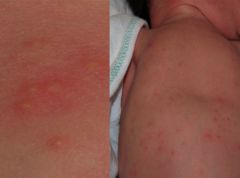
**small papules, vesicles, or pustules surrounded by blotchy erythema; can resemble herpes • appears in first week; disappears within 1-2 weeks • filled w/ eosinophiles on smear |
|
|
miliaria |
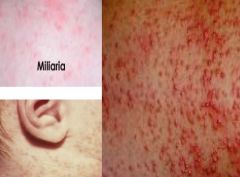
**heat rash, sweat glands become occluded • if occlusion is deeper >> miliaria rubra • if symptomatic >> topic antibiotics |
|
|
sebaceous hyperplasia |
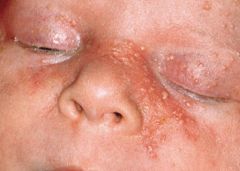
**small white/yellow papules on nose, <0.5 mm • hyperandrogenous state |
|
|
milia |
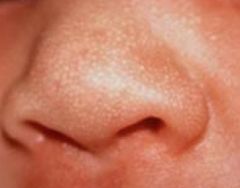
**pearly white/yellow papules; ~1 mm • usually brow, cheek, & nose • epidermal cyst caused by accumulation of sebaceous gland secretions • resolve spontaneously during first weeks • epstein pearls when found in mouth; will usually go away as infants suck |
|
|
sucking bister |
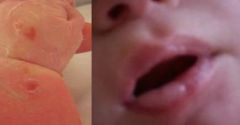
**vesicles or bullae on lips, fingers, hands • result of vigorous sucking • require no treatment • r/o herpes w/ mom's history |
|
|
harlequin color change |
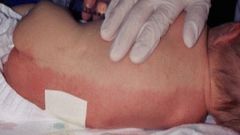
**lying on one side sharply demarcated red color on dependent half of body • only seen in newborn period; up to 4-6 weeks • common in LBW • benign; temporary imbalance of autonomic regulatory mechanism of cutaneous vessels |
|
|
transient neonatal pustular melanosis (TNPM) |
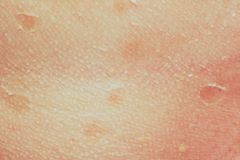
• superficial, vesiculopustular lesions • rupture within 12-48 hours >> leaves small pigmented macules surrounded by white scales • remains up to 3 mos • aspiration reveals neutrophils & almost no eosinophils |
|
|
mongolian spots |
• hyperpigmented macule • 90% AA, asian, hispanic • melanocytes infiltrate dermis >> fade over first three years |
|
|
hemangioma of infancy (HOI) |

• most common in white newborns • grow rapidly within first five months • no interventions in most cases |
|
|
T/F. Involution of hemangioma will result in perfectly normal skin. |
False; may leave silver/gray coloring |
|
|
Which hemangiomas will involute? |
will involute-- • HOI
will not involute-- • NICH- non-involuting congenital hemangiomas • VM- venous malformations are progressive |
|
|
T/F. Hemangiomas near the eye, mouth, and airway need to be treated. |
True; dangerous to vision & airway |
|
|
hemangioma treatments |
1/ prednisolone PO-- • 3-5 mg/kg/day • 3-18 mos treatment • mood changes & HTN common • urosepsis in female infant
2/ propranolol PO-- • 2 mg/kg/day TID w/ meals • early referral by week 6
3/ laser by dermatology |
|
|
dacryostenosis |
**congenital nasolacrimal duct obstruction • intermittent to constant tearing or visible drainage • unilateral or bilateral • dacryocystitis • 73% of term infants >> 90% resolves spontaneously |
|
|
dacryostenosis exam & treatment |
exam-- • firm blue/gray swelling in nasolacrimal area • eye exam is normal
treatment-- • moist warm soaks, massage 4-6x per day • ophthalmology referral if unresolved @ 12 months |
|
|
dacryostenosis differential |
• excessive tearing • foreign body • corneal abrasion • glaucoma • rhinorrhea w/ tearing • chlamydia conjunctivitis |
|
|
oral candidiasis |
**thrush; white plaques that doesn't come off • inflamed buccal mucosa • may be a/w cutaneous candidiasis in diaper area • recurrent/severe >> s&s of HIV disease or immune deficiency • both mom & baby should be treated; treat mom to air dry |
|
|
thrush history & treatment |
history-- • fuzzy, can be asymptomatic • maternal HIV infection • recent antibiotic use
treatment-- • nystatin • flucanazole |
|
|
congenital stridor |
**high-pitch upper airway crowing • laryngotracheomalacia (ENT) • subglottic stenosis |
|
|
congenital stridor history & PE |
history-- • onset, severity, condition • risk factors, i.e. intubation, birth trauma, GERD
PE-- • retractions • cyanosis, apnea • poor feeding >> FTT • identify lesion site |
|
|
stuffed nose & URI treatment |
• normal saline nose drop/spray • nasal aspirator |
|
|
respiratory red flags |
• tachypnea; >60-65 bpm • retractions, grunting • cyanosis RA • noisy or decreased auscultation |
|
|
congenital malformations |
• choanal atresia/stenosis • micrognathia w/ or w/o cleft palate • congenital laryngeal or tracheal stenosis • severe tracheomalacia • diaphragmatic hernia • pulmonary hypoplasia • congenital lobar emphysema |
|
|
transient tachypnea of newborn (TTN) |
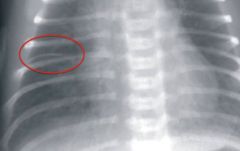
patho-- • rapid breathing caused by alveolar retention of amniotic fluid • more common in GDM & c-section • gets better w/ time
s&s-- • minimal O2 needs • precipitated by cold stress • streaky fluid line on chest xray |
|
|
chlamydia conjunctivitis |
• c. trachomatis causes neonatal conjunctivitis, trachoma, pneumonia • typically develops 5-14 days s/p birth • lasts 2 weeks • watery to mucopurulent eye discharge • pseudomembrane w/ bloody discharge
treatment-- • routine prophylactic drops of silver nitrate • erythromycin 50 mg/kg QID x2weeks PO |
|
|
chlamydia pneumonia |
• 2-19 weeks • preceding signs include rhinorrhea, congestion, & conjunctivitis • tachypnea w/ persistent staccato cough • congestion, rales, & rare wheezing • preterm infants can have apnea |
|
|
What is the gold standard for diagnosis chlamydia pneumonia? |
Culture is highly specific and sensitive, containing epithelial cells. Chest x-ray is vague and show hyperinflation and infiltrates. |
|
|
chlamydia pneumonia treatment |
erythromycin |
|
|
pneumothorax etiology & clinical features |
etiology-- • spontaneous or a/w meconium aspiration • bacterial pneumonia • sepsis • respiratory distress syndrome • resuscitative measures
s&s-- • (-) breath sounds w/ or w/o mediastinal shift • clear area w/ distinct margin & absent lung sounds • non-distressed tachypnea • retractions |
|
|
pneumothorax nontension v. tension |
Non-tension can be watched whereas tension pneumothorax may require a chest tube. |
|
|
pneumothorax diagnostic evaluation |
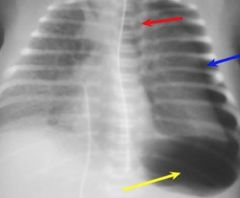
• pass catheter into nares to r/o choanal atreasia • abdomen- r/o scaphoid >> diaphramatic hernia • inspect oropharynx & neck • chest x-ray |

